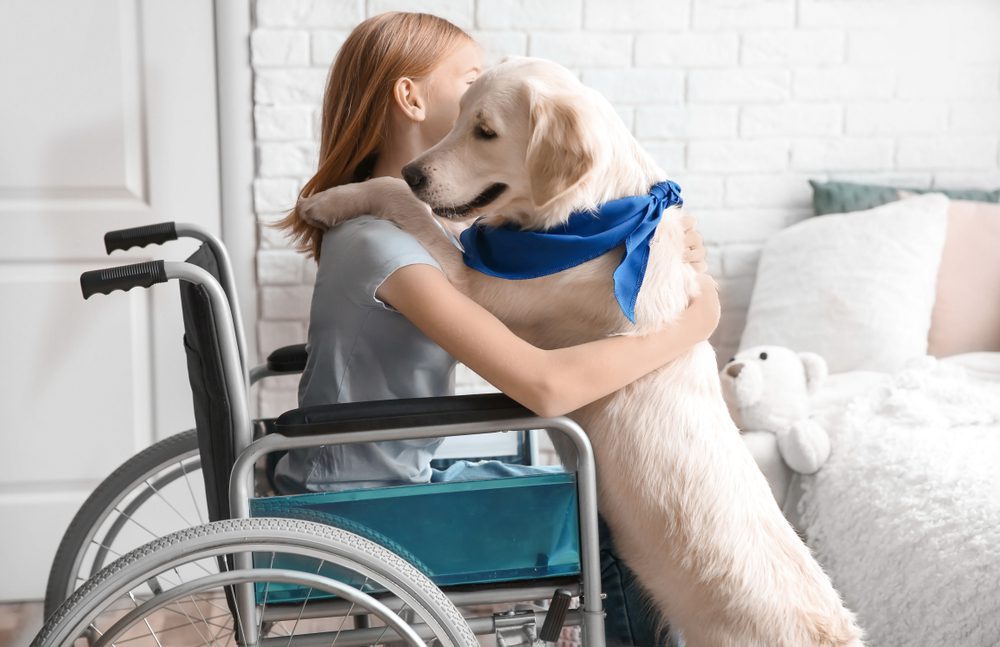Share This Article
Throughout human history, animals have been trained to perform various tasks that would be difficult or impossible for people to do on their own. While at first animals were really only seen as a tool to be used to accomplish a job, that quickly changed. Strong emotional bonds formed between people and animals, which helped to transform many of them from a resource into pets, and even friends.
Today, humans and many species of animals have formed a truly symbiotic relationship where both the animal and the person enhance each other’s lives in many ways. In some cases, the relationship between a person and an animal is formalized and given special legal recognition because of how critical it is.
Animals Providing Care to Humans
Animals that are recognized under the law, and by society as a whole, as providing essential services to people are generally broken up into two categories.
The first, and most recognizable, is the service animal. Service animals are trained to be able to perform specific tasks that will help their human overcome specific challenges related to a mental or physical issue.
The other option is an emotional support animal (ESA). There are far fewer requirements or regulations in place for ESAs, but they do provide millions of people with great benefits.
Mental Health Support Animal Options
If you or someone you love struggles with any type of mental health issue, it is likely that an animal would be able to provide assistance. There are two options to consider. The first is a psychiatric service dog, and the second is an emotional support animal.
What Exactly Is a Psychiatric Service Dog?
A psychiatric service dog is a specific type of service dog under federal law. This means that the animal is specifically trained to perform tasks that will provide some type of benefit to someone who has a diagnosed mental health problem.
Since these animals are given intensive training, the things that they can do will vary significantly based on what types of needs the person for whom they are helping has. The following are just a few examples of different tasks that a psychiatric service dog can be trained to perform.
- Medication Reminders – Dogs can be trained to remind their person to take medications.
- Self-Harm Avoidance – Someone who struggles with self-harm can benefit from a dog that is trained to intervene before they hurt themselves.
- Searching a Room – Many people with PTSD or other similar issues worry about intruders in their homes. A psychiatric service dog can enter the home first to determine if anyone is there.
- Hallucination Identification – People who suffer from hallucinations can have their dog identify whether something they see is real or a hallucination so that they can respond accordingly.
- Seek Assistance – When a person is having an emergency of any type, the dog can be trained to seek help either by getting the attention of someone in the area or even placing a phone call for assistance.
These are just a small number of the different tasks that a psychiatric service dog can perform. If you or a loved one could benefit from this type of help, a dog would be trained specifically based on your needs.
One other important thing about psychiatric service animals (or any type of service animal) is that the species must be either a dog or a miniature horse. Of course, the vast majority of all service animals are dogs.

What Exactly Is an Emotional Support Animal?
An emotional support animal is there to help a person by providing emotional comfort. These animals are most often recommended by psychologists, therapists, or other counselor. An ESA can be any type of animal, which is important because people bond to different types of animals. The most common species for ESAs include dogs, cats, miniature pigs, rabbits, ferrets, and horses.
Since there are no legal restrictions on what species can serve as an emotional support animal, however, there have also been many more exotic examples. This includes squirrels, monkeys, turtles, and even goats.
The biggest difference between a psychiatric service dog and an emotional support animal is that the ESA does not have to be given any special training. This is because their role is to provide comfort and emotional support to their owner. Since what is considered comforting or supporting will vary from person to person, no specific tasks need to be taught.
Since emotional support animals are often allowed to go into areas where normal pets cannot, however, it is important that they are well-behaved. Anyone who wants to get the most benefit from their emotional support animal will want to make sure they train them so they do not bark, bite, or cause damage when out in public. Taking the time to train your dog or other support animal will ensure they are welcomed everywhere they go.
How These Animals Are Seen Under the Law
One of the most important differences between a psychiatric service dog and an emotional support animal is how they are viewed under the law. If you are thinking about getting any type of support animal, you will want to have a good understanding of all of your legal rights and responsibilities.
Federal Law
In the United States, the federal government has passed laws and regulations that ensure service animals, including psychiatric service dogs, are permitted to perform the tasks they were trained for. This is primarily covered under the Americans with Disabilities Act (ADA).
Under this law, service dogs must be allowed to enter buildings where other animals are prohibited. This includes stores, apartments, schools, libraries, and many more. When it comes to service dogs, the legal protections are quite extensive and allow you to bring them just about everywhere with very few restrictions.
The ADA specifically states that emotional support animals are not the same things as service dogs and are not afforded the same rights. However, emotional support animals are given legal protections when it comes to things like being allowed to live in an apartment that normally does not permit pets. It also prevents landlords from charging extra fees for having the ESA.
In general, the legal rights of emotional support animals are more restrictive. However, most people and businesses will provide exceptions to normal rules for these animals.
Since an ESA can be any species, there are limitations on what protections they are given. Specifically, emotional support animals must be given ‘reasonable accommodations,’ which is an intentionally vague requirement. This allows a landlord to allow a well-trained dog in an apartment while still preventing someone from demanding that they allow their pet tiger to live with them as an emotional support animal.
State Laws and Local Laws
In addition to federal laws related to service dogs and emotional support animals, there are also state and local laws that you will want to be aware of. Each state has its own set of standards regarding what legal protections these animals have.
Since psychiatric service dogs are generally given extensive rights under federal laws, state and local laws will usually only just serve to strengthen those rights. For emotional support animals, however, individual states often offer additional rights that are not identified federally.
If you want a service dog or an emotional support animal, it is a good idea to look up the various legal protections they will receive in your state.
Meeting Your Mental Health Needs
If you struggle with any type of mental health challenges, you may enjoy many benefits from having an animal at your side. Deciding whether you should have a psychiatric service dog or an emotional support animal can be difficult, but it is well worth the effort.
Do You Need a Psychiatric Service Dog?
The simplest way to determine if a psychiatric service dog is right for you is to ask yourself if you could benefit from a dog that is trained to perform specific tasks to help you overcome your mental health challenges.
For example, if you are someone who struggles with anxiety attacks, and if you could you benefit from a dog that can detect when one is beginning and take some action to provide immediate relief, then a psychiatric service dog is an excellent option.
Do You Need an Emotional Support Animal?
If you find that you do not have any specific actions that you need an animal to take to help you, then an emotional support animal may be a better option. ESAs provide many people with significant help simply by being there as emotional support.
Most people know that simply holding or petting an animal can help to make you feel better. If this is what you need, then an ESA is a great option to consider.
Always Talk With Your Mental Healthcare Professional
In the end, it is always a good idea to speak with your mental healthcare professional to get their opinion. They can help you to determine whether you would benefit more from a psychiatric service dog or an emotional support animal.

